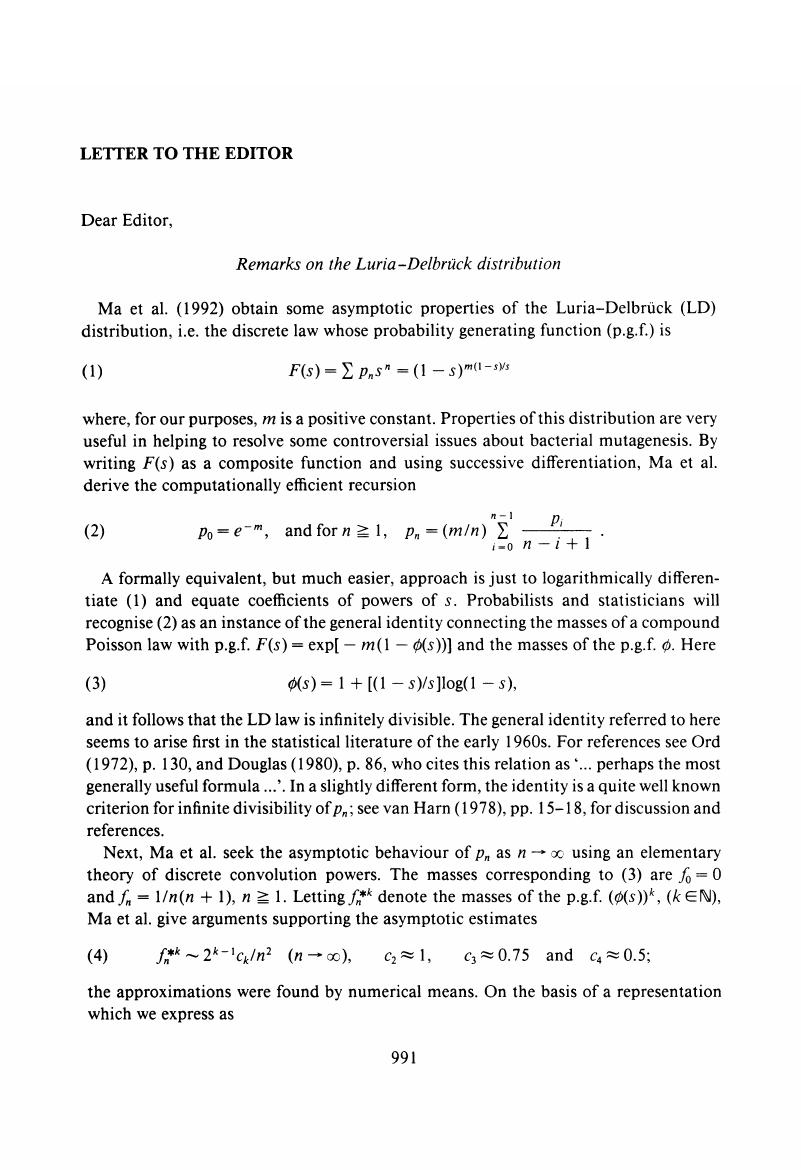Crossref Citations
This article has been cited by the following publications. This list is generated based on data provided by Crossref.
Jaeger, Gregg
and
Sarkar, Sahotra
1995.
On the distribution of bacterial mutants: The effects of differential fitness of mutants and non-mutants.
Genetica,
Vol. 96,
Issue. 3,
p.
217.
Goldie, Charles M.
1995.
Asymptotics of the Luria-Delbrück distribution.
Journal of Applied Probability,
Vol. 32,
Issue. 3,
p.
840.
Goldie, Charles M.
1995.
Asymptotics of the Luria-Delbrück distribution.
Journal of Applied Probability,
Vol. 32,
Issue. 03,
p.
840.
Nádas, Arthur
Goncharova, Ekaterina I.
and
Rossman, Toby G.
1996.
Mutations and infinity: Improved statistical methods for estimating spontaneous rates.
Environmental and Molecular Mutagenesis,
Vol. 28,
Issue. 2,
p.
90.
Prodinger, Helmut
1996.
Asymptotics of the Luria-Delbrück distribution via singularity analysis.
Journal of Applied Probability,
Vol. 33,
Issue. 01,
p.
282.
Prodinger, Helmut
1996.
Asymptotics of the Luria-Delbrück distribution via singularity analysis.
Journal of Applied Probability,
Vol. 33,
Issue. 1,
p.
282.
Hilberdink, Titus
1999.
An Integral Formula for Taylor Coefficients of a Class of Analytic Functions.
Journal of Mathematical Analysis and Applications,
Vol. 233,
Issue. 1,
p.
266.
Zheng, Qi
1999.
Progress of a half century in the study of the Luria–Delbrück distribution.
Mathematical Biosciences,
Vol. 162,
Issue. 1-2,
p.
1.
Angerer, Wolfgang P.
2001.
A note on the evaluation of fluctuation experiments.
Mutation Research/Fundamental and Molecular Mechanisms of Mutagenesis,
Vol. 479,
Issue. 1-2,
p.
207.
Zheng, Qi
2002.
Statistical and algorithmic methods for fluctuation analysis with SALVADOR as an implementation.
Mathematical Biosciences,
Vol. 176,
Issue. 2,
p.
237.
Zheng, Qi
2003.
Mathematical Issues Arising From the Directed Mutation Controversy.
Genetics,
Vol. 164,
Issue. 1,
p.
373.
Gusev, Y.
and
Armitage, Peter
2005.
Encyclopedia of Biostatistics.
Möhle, M.
2005.
Convergence results for compound Poisson distributions and applications to the standard Luria–Delbrück distribution.
Journal of Applied Probability,
Vol. 42,
Issue. 03,
p.
620.
Möhle, M.
2005.
Convergence results for compound Poisson distributions and applications to the standard Luria–Delbrück distribution.
Journal of Applied Probability,
Vol. 42,
Issue. 3,
p.
620.
Zheng, Qi
2007.
On Haldane’s formulation of Luria and Delbrück’s mutation model.
Mathematical Biosciences,
Vol. 209,
Issue. 2,
p.
500.
Zheng, Qi
2008.
A note on plating efficiency in fluctuation experiments.
Mathematical Biosciences,
Vol. 216,
Issue. 2,
p.
150.
Zheng, Qi
2008.
On Bartlett’s formulation of the Luria–Delbrück mutation model.
Mathematical Biosciences,
Vol. 215,
Issue. 1,
p.
48.
Zheng, Qi
2009.
Letter to the Editor.
Journal of Applied Probability,
Vol. 46,
Issue. 4,
p.
1221.
Zheng, Qi
2009.
Letter to the Editor.
Journal of Applied Probability,
Vol. 46,
Issue. 04,
p.
1221.
Zheng, Qi
2010.
A new discrete distribution induced by the Luria–Delbrück mutation model.
Statistics,
Vol. 44,
Issue. 5,
p.
529.



